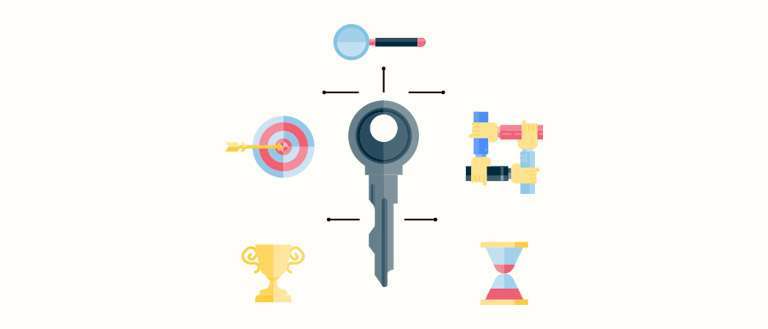Whether your business is growing big or you are still in the early days trying to win your first slot of customers- the primary goal still remains the same: influence your potential customers. And in order to win those customers and become profitable, your B2B brand is going to need a content marketing strategy.
What is B2B Content Marketing?
A B2B content marketing is used to bring you in front of your ideal clients and address their issues so they can discover more about your company. Content marketing is frequently cited as the reason for a B2B company’s success. With a strong B2B content marketing strategy, your company can expand its reach, become a known and trusted industry authority, and ultimately set a strong foundation for new and ongoing client relationships.
Why Do B2B Companies Need Content Marketing?
You might feel hesitant to invest in various B2B content marketing strategies, especially if your business relies heavily on word of mouth and you find your clients through existing partners. But whatever your customer acquiring strategy is, there are a few reasons you can’t say no to content marketing. Let’s have a look at them.
Great Return on Investment
It may appear like creating a content strategy will cost you a lot of money. However, if your B2B strategy is effective, your investment will be profitable.
The ROI for each B2B marketing approach will differ. An ROI of 110 percent, for instance, can be achieved with email marketing. The precise percentage will depend on your respective objectives for content marketing. However, it won’t be a waste of money if your method is well thought out.
More Exposure to Brands
A Content Marketing Institute report claims that by 2020, brand promotion will make up 50% of all B2B content. Hence, to increase brand exposure, B2B businesses frequently use content marketing strategies. As a result, content has now become the core element that makes your business stand out. If you use the content properly, it will set you apart from rivals and increase awareness of your business.
Establish Authority
B2B marketers build channels to educate potential clients by investing in a content marketing strategy. Your authority in the sector is also impacted by the content material you create and distribute. In fact, a study found that 18% of B2B buyers examine a product offline and 27% of their time is spent researching it online.
How to Build an Effective B2B Content Marketing Strategy?
After going over the theory, it’s time to talk about how to create a compelling B2B content strategy to help your business grow.
1. Understand Your Audience
If you are clueless about your customer’s pain points and are just making a wild guess, know that your chances of flopping are much higher. The best marketers don’t just learn about the latest channel, tool, or tactic. They know more about people.
It’s also a good idea to regularly poll and converse with your audience. Gift cards might be used as incentives, or you could just politely request ten minutes from your most committed clients. Inquire about their present struggles and ongoing projects for their company.
For example: To better understand your business you can start by checking out relevant YouTube videos. In the comments section, you’ll find all sorts of questions related to your industry. Read through questions in the comments section and take note of the ones that match your ideal target audience.

2. See Which Strategies Worked in the Past
Next comes the big WHAT!
What do you want to achieve with your content marketing strategy? It is essential to define your primary content marketing strategy goal from the onset.
Decide the metric or outcome you wish to emphasize, then research your competitors. Apply the Sherlock Homeboy Method. Wait….but do you know what it is? Well, Sherlock Homeboy Method involves looking for content marketing ideas or plans that worked in the past and reverse engineering them. It focuses on identifying content formats, title ideas, subject trends, and marketing strategies that have worked in the past and can be applied again.

3. Establish Key Objectives and Metrics
Every organization in this world is striving for success. But how “success” is evaluated and what success looks like varies greatly from one business to the next. The same is true for B2B marketing plans. A good approach may result in higher sales, greater exposure, more leads, more customers, and a long list of other outcomes.
- First, determine your company’s objectives. How will success be measured?
- Determine what actions and outcomes will help you accomplish your business goals and succeed by working backward from that aim.
- Link these actions to metrics you can monitor to demonstrate progress.
Make sure your objectives are SMART, though!
- Measurable: Make sure there is a way for progress and success to be tracked.
- Achievable: Your goals should not be unrealistic but rather practically possible to achieve.
- Specific: Explain exactly what you are trying to accomplish.
- Relevant: If your goal doesn’t align with your business goals and won’t directly impact your overall success, it’s not worth setting.
- Time-bound: Simply put, a goal without a deadline is just a dream.

4. Develop Your B2B Customer Journey Map
You can use the customer journey map to get a better understanding of the different touchpoints that your B2B marketing plan involves as customers progress through the sales funnel. Also, what influences their decisions and any potential questions they may have. Here’s how you can get started with a journey map:
- Detail the factors that will most likely have an impact on customers at each stage.
- At each stage of the purchasing cycle, determine the key stakeholders and who needs to buy in.
- Think of a few fast topics for content that could address these inquiries.
- List the types of content you intend to use at each step.
Knowing the precise problems your clients are facing at each point of their journey will enable you to assist them by reaching out to them at the right moment with the appropriate message.

5. Identify Executional Marketing Tactics
You’ll have your consumer research, a map of the customer journey, qualitative and quantitative analysis, a description of your key KPIs, and SMART goals by this point. Now is the moment to plan out how you want to accomplish those objectives.
Ask yourself the following questions:
- Which strategies are you planning to try?
- What distribution methods are you intending to try out?
- Will you formally distribute the case studies through these channels?
- Do you use material such as blog articles and videos to draw in customers first?
Now, it’s time for execution. Follow the marketing tactics stated below:
- Publish no less than two blog entries each month.
- Each week, produce 1 short video for social media.
- Participate as a guest on at least one podcast each month.
- Conduct at least one link-building outreach effort each week.

Kick Start Your Content Marketing Strategy Today!
Whether you’re starting from scratch or overhauling your existing content marketing efforts, the people involved in creating marketing strategy can make all the difference. Use the methods mentioned above to create your own content marketing strategy or contact professionals like KnotSync. Our team of experienced content marketing strategists can help you achieve your marketing objectives.
What are you waiting for? It’s time to have a solid strategy to amplify your brand and grow your business! Let’s get started!




